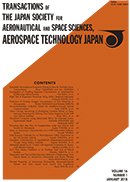最新号
(ISTS Special Issue: Selected papers from the 26th International Symposium on Space Technology and Science)
選択された号の論文の250件中201~250を表示しています
m) Scientific Observations and Related Technologies
-
2009 年 7 巻 ists26 号 p. Tm_1-Tm_6
発行日: 2009年
公開日: 2009/05/01
PDF形式でダウンロード (669K) -
2009 年 7 巻 ists26 号 p. Tm_7-Tm_11
発行日: 2009年
公開日: 2009/05/21
PDF形式でダウンロード (2855K) -
2009 年 7 巻 ists26 号 p. Tm_13-Tm_18
発行日: 2009年
公開日: 2009/08/24
PDF形式でダウンロード (521K) -
2009 年 7 巻 ists26 号 p. Tm_19-Tm_23
発行日: 2009年
公開日: 2009/09/15
PDF形式でダウンロード (1760K) -
2009 年 7 巻 ists26 号 p. Tm_25-Tm_29
発行日: 2009年
公開日: 2009/09/15
PDF形式でダウンロード (554K) -
2009 年 7 巻 ists26 号 p. Tm_31-Tm_35
発行日: 2009年
公開日: 2009/10/22
PDF形式でダウンロード (1125K) -
2009 年 7 巻 ists26 号 p. Tm_37-Tm_45
発行日: 2009年
公開日: 2009/12/27
PDF形式でダウンロード (7262K) -
2009 年 7 巻 ists26 号 p. Tm_47-Tm_53
発行日: 2009年
公開日: 2010/02/16
PDF形式でダウンロード (1119K) -
2009 年 7 巻 ists26 号 p. Tm_55-Tm_60
発行日: 2009年
公開日: 2010/06/08
PDF形式でダウンロード (791K)
n) Earth Observation
-
2009 年 7 巻 ists26 号 p. Tn_1-Tn_6
発行日: 2009年
公開日: 2009/09/15
PDF形式でダウンロード (576K) -
2009 年 7 巻 ists26 号 p. Tn_7-Tn_12
発行日: 2009年
公開日: 2009/09/15
PDF形式でダウンロード (5029K) -
2009 年 7 巻 ists26 号 p. Tn_13-Tn_16
発行日: 2009年
公開日: 2009/09/15
PDF形式でダウンロード (561K) -
2009 年 7 巻 ists26 号 p. Tn_17-Tn_20
発行日: 2009年
公開日: 2009/10/22
PDF形式でダウンロード (1645K) -
2009 年 7 巻 ists26 号 p. Tn_21-Tn_25
発行日: 2009年
公開日: 2009/12/17
PDF形式でダウンロード (960K) -
2009 年 7 巻 ists26 号 p. Tn_27-Tn_30
発行日: 2009年
公開日: 2009/12/27
PDF形式でダウンロード (501K)
p) Life Science and Human Presence
-
2009 年 7 巻 ists26 号 p. Tp_1-Tp_5
発行日: 2009年
公開日: 2009/06/13
PDF形式でダウンロード (342K) -
2009 年 7 巻 ists26 号 p. Tp_7-Tp_10
発行日: 2009年
公開日: 2009/08/24
PDF形式でダウンロード (880K) -
2009 年 7 巻 ists26 号 p. Tp_11-Tp_18
発行日: 2009年
公開日: 2010/05/08
PDF形式でダウンロード (553K)
r-1) Space Exploration, International Cooperation and New Missions
-
2009 年 7 巻 ists26 号 p. Tr_1_1-Tr_1_4
発行日: 2009年
公開日: 2009/06/13
PDF形式でダウンロード (1813K) -
2009 年 7 巻 ists26 号 p. Tr_1_5-Tr_1_10
発行日: 2009年
公開日: 2010/02/16
PDF形式でダウンロード (814K)
r-2) Space Environment and Debris
-
2009 年 7 巻 ists26 号 p. Tr_2_1-Tr_2_4
発行日: 2009年
公開日: 2009/05/21
PDF形式でダウンロード (592K) -
2009 年 7 巻 ists26 号 p. Tr_2_5-Tr_2_10
発行日: 2009年
公開日: 2009/05/21
PDF形式でダウンロード (577K) -
2009 年 7 巻 ists26 号 p. Tr_2_11-Tr_2_14
発行日: 2009年
公開日: 2009/06/02
PDF形式でダウンロード (673K) -
2009 年 7 巻 ists26 号 p. Tr_2_15-Tr_2_19
発行日: 2009年
公開日: 2009/06/13
PDF形式でダウンロード (2536K) -
2009 年 7 巻 ists26 号 p. Tr_2_21-Tr_2_26
発行日: 2009年
公開日: 2009/06/13
PDF形式でダウンロード (1583K) -
2009 年 7 巻 ists26 号 p. Tr_2_27-Tr_2_32
発行日: 2009年
公開日: 2009/06/13
PDF形式でダウンロード (796K) -
2009 年 7 巻 ists26 号 p. Tr_2_33-Tr_2_36
発行日: 2009年
公開日: 2009/09/15
PDF形式でダウンロード (591K) -
2009 年 7 巻 ists26 号 p. Tr_2_37-Tr_2_39
発行日: 2009年
公開日: 2009/09/15
PDF形式でダウンロード (378K) -
2009 年 7 巻 ists26 号 p. Tr_2_41-Tr_2_45
発行日: 2009年
公開日: 2009/09/15
PDF形式でダウンロード (2832K) -
2009 年 7 巻 ists26 号 p. Tr_2_47-Tr_2_51
発行日: 2009年
公開日: 2009/10/22
PDF形式でダウンロード (641K) -
2009 年 7 巻 ists26 号 p. Tr_2_53-Tr_2_56
発行日: 2009年
公開日: 2009/10/22
PDF形式でダウンロード (535K) -
2009 年 7 巻 ists26 号 p. Tr_2_57-Tr_2_62
発行日: 2009年
公開日: 2009/11/28
PDF形式でダウンロード (1888K) -
2009 年 7 巻 ists26 号 p. Tr_2_63-Tr_2_66
発行日: 2009年
公開日: 2009/12/19
PDF形式でダウンロード (3002K) -
2009 年 7 巻 ists26 号 p. Tr_2_67-Tr_2_70
発行日: 2009年
公開日: 2010/02/16
PDF形式でダウンロード (2378K) -
2009 年 7 巻 ists26 号 p. Tr_2_71-Tr_2_74
発行日: 2009年
公開日: 2010/05/08
PDF形式でダウンロード (536K) -
2009 年 7 巻 ists26 号 p. Tr_2_75-Tr_2_78
発行日: 2009年
公開日: 2010/05/08
PDF形式でダウンロード (536K)
r-3) Space Law and Policy
-
2009 年 7 巻 ists26 号 p. Tr_3_1-Tr_3_5
発行日: 2009年
公開日: 2009/12/29
PDF形式でダウンロード (436K)
t) Systems Engineering and Information Technology
-
2009 年 7 巻 ists26 号 p. Tt_1-Tt_6
発行日: 2009年
公開日: 2009/05/21
PDF形式でダウンロード (458K) -
2009 年 7 巻 ists26 号 p. Tt_7-Tt_12
発行日: 2009年
公開日: 2009/06/13
PDF形式でダウンロード (419K) -
2009 年 7 巻 ists26 号 p. Tt_13-Tt_17
発行日: 2009年
公開日: 2010/05/08
PDF形式でダウンロード (453K)
u) Space Education and Outreach for the Benefit of All People
-
2009 年 7 巻 ists26 号 p. Tu_1-Tu_5
発行日: 2009年
公開日: 2009/10/22
PDF形式でダウンロード (774K) -
2009 年 7 巻 ists26 号 p. Tu_7-Tu_12
発行日: 2009年
公開日: 2009/10/22
PDF形式でダウンロード (1152K) -
2009 年 7 巻 ists26 号 p. Tu_13-Tu_18
発行日: 2009年
公開日: 2009/11/28
PDF形式でダウンロード (835K) -
2009 年 7 巻 ists26 号 p. Tu_19-Tu_23
発行日: 2009年
公開日: 2009/11/28
PDF形式でダウンロード (576K) -
2009 年 7 巻 ists26 号 p. Tu_25-Tu_29
発行日: 2009年
公開日: 2009/12/27
PDF形式でダウンロード (1054K) -
2009 年 7 巻 ists26 号 p. Tu_31-Tu_34
発行日: 2009年
公開日: 2009/12/27
PDF形式でダウンロード (572K) -
2009 年 7 巻 ists26 号 p. Tu_35-Tu_40
発行日: 2009年
公開日: 2010/02/16
PDF形式でダウンロード (477K) -
2009 年 7 巻 ists26 号 p. Tu_41-Tu_45
発行日: 2009年
公開日: 2010/02/16
PDF形式でダウンロード (866K) -
2009 年 7 巻 ists26 号 p. Tu_47-Tu_50
発行日: 2009年
公開日: 2010/03/11
PDF形式でダウンロード (557K) -
2009 年 7 巻 ists26 号 p. Tu_51-Tu_55
発行日: 2009年
公開日: 2010/06/08
PDF形式でダウンロード (652K)
